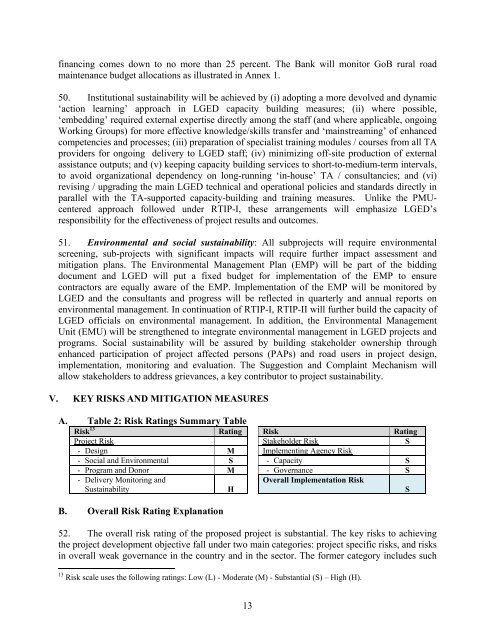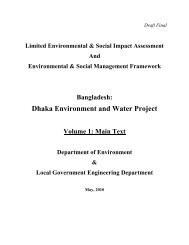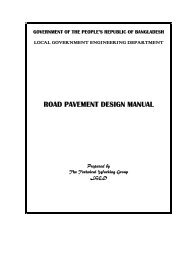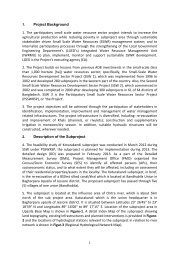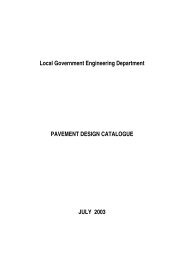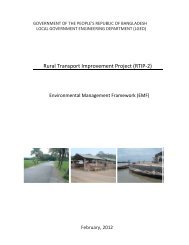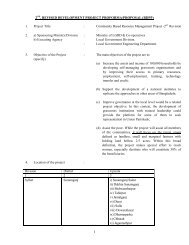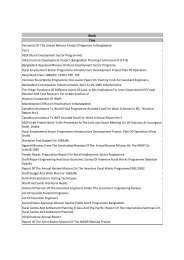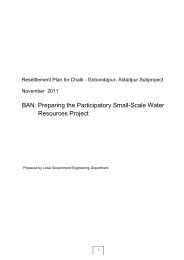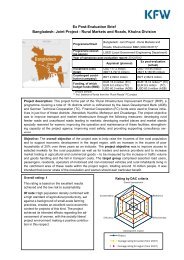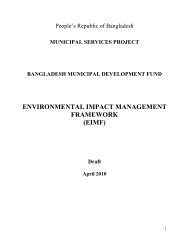PAD - LGED
PAD - LGED
PAD - LGED
Create successful ePaper yourself
Turn your PDF publications into a flip-book with our unique Google optimized e-Paper software.
financing comes down to no more than 25 percent. The Bank will monitor GoB rural road<br />
maintenance budget allocations as illustrated in Annex 1.<br />
50. Institutional sustainability will be achieved by (i) adopting a more devolved and dynamic<br />
‘action learning’ approach in <strong>LGED</strong> capacity building measures; (ii) where possible,<br />
‘embedding’ required external expertise directly among the staff (and where applicable, ongoing<br />
Working Groups) for more effective knowledge/skills transfer and ‘mainstreaming’ of enhanced<br />
competencies and processes; (iii) preparation of specialist training modules / courses from all TA<br />
providers for ongoing delivery to <strong>LGED</strong> staff; (iv) minimizing off-site production of external<br />
assistance outputs; and (v) keeping capacity building services to short-to-medium-term intervals,<br />
to avoid organizational dependency on long-running ‘in-house’ TA / consultancies; and (vi)<br />
revising / upgrading the main <strong>LGED</strong> technical and operational policies and standards directly in<br />
parallel with the TA-supported capacity-building and training measures. Unlike the PMUcentered<br />
approach followed under RTIP-I, these arrangements will emphasize <strong>LGED</strong>’s<br />
responsibility for the effectiveness of project results and outcomes.<br />
51. Environmental and social sustainability: All subprojects will require environmental<br />
screening, sub-projects with significant impacts will require further impact assessment and<br />
mitigation plans. The Environmental Management Plan (EMP) will be part of the bidding<br />
document and <strong>LGED</strong> will put a fixed budget for implementation of the EMP to ensure<br />
contractors are equally aware of the EMP. Implementation of the EMP will be monitored by<br />
<strong>LGED</strong> and the consultants and progress will be reflected in quarterly and annual reports on<br />
environmental management. In continuation of RTIP-I, RTIP-II will further build the capacity of<br />
<strong>LGED</strong> officials on environmental management. In addition, the Environmental Management<br />
Unit (EMU) will be strengthened to integrate environmental management in <strong>LGED</strong> projects and<br />
programs. Social sustainability will be assured by building stakeholder ownership through<br />
enhanced participation of project affected persons (PAPs) and road users in project design,<br />
implementation, monitoring and evaluation. The Suggestion and Complaint Mechanism will<br />
allow stakeholders to address grievances, a key contributor to project sustainability.<br />
V. KEY RISKS AND MITIGATION MEASURES<br />
A. Table 2: Risk Ratings Summary Table<br />
Risk 13 Rating Risk Rating<br />
Project Risk Stakeholder Risk S<br />
- Design M Implementing Agency Risk<br />
- Social and Environmental S - Capacity S<br />
- Program and Donor M - Governance S<br />
- Delivery Monitoring and<br />
Sustainability<br />
H<br />
Overall Implementation Risk<br />
S<br />
B. Overall Risk Rating Explanation<br />
52. The overall risk rating of the proposed project is substantial. The key risks to achieving<br />
the project development objective fall under two main categories: project specific risks, and risks<br />
in overall weak governance in the country and in the sector. The former category includes such<br />
13 Risk scale uses the following ratings: Low (L) - Moderate (M) - Substantial (S) – High (H).<br />
13


